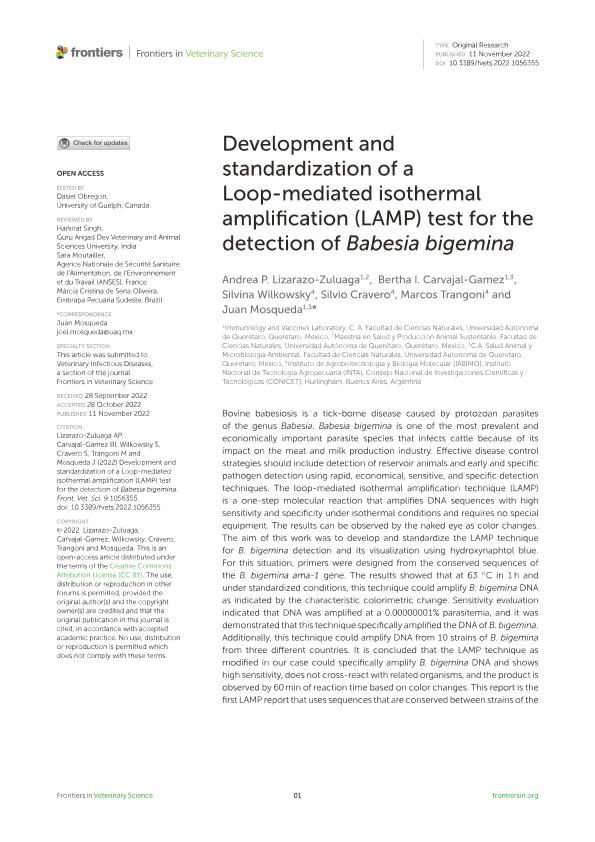Artículo
Development and standardization of a Loop-mediated isothermal amplification (LAMP) test for the detection of Babesia bigemina
Lizarazo Zuluaga, Andrea P.; Carvajal Gamez, Bertha I.; Wilkowsky, Silvina Elizabeth ; Cravero, Silvio Lorenzo Pedro; Trangoni, Marcos David; Mosqueda, Juan
; Cravero, Silvio Lorenzo Pedro; Trangoni, Marcos David; Mosqueda, Juan
 ; Cravero, Silvio Lorenzo Pedro; Trangoni, Marcos David; Mosqueda, Juan
; Cravero, Silvio Lorenzo Pedro; Trangoni, Marcos David; Mosqueda, Juan
Fecha de publicación:
11/2022
Editorial:
Frontiers Media
Revista:
Frontiers in Veterinary Science
e-ISSN:
2297-1769
Idioma:
Inglés
Tipo de recurso:
Artículo publicado
Clasificación temática:
Resumen
Bovine babesiosis is a tick-borne disease caused by protozoan parasites of the genus Babesia. Babesia bigemina is one of the most prevalent and economically important parasite species that infects cattle because of its impact on the meat and milk production industry. Effective disease control strategies should include detection of reservoir animals and early and specific pathogen detection using rapid, economical, sensitive, and specific detection techniques. The loop-mediated isothermal amplification technique (LAMP) is a one-step molecular reaction that amplifies DNA sequences with high sensitivity and specificity under isothermal conditions and requires no special equipment. The results can be observed by the naked eye as color changes. The aim of this work was to develop and standardize the LAMP technique for B. bigemina detection and its visualization using hydroxynaphtol blue. For this situation, primers were designed from the conserved sequences of the B. bigemina ama-1 gene. The results showed that at 63 °C in 1 h and under standardized conditions, this technique could amplify B. bigemina DNA as indicated by the characteristic colorimetric change. Sensitivity evaluation indicated that DNA was amplified at a 0.00000001% parasitemia, and it was demonstrated that this technique specifically amplified the DNA of B. bigemina. Additionally, this technique could amplify DNA from 10 strains of B. bigemina from three different countries. It is concluded that the LAMP technique as modified in our case could specifically amplify B. bigemina DNA and shows high sensitivity, does not cross-react with related organisms, and the product is observed by 60 min of reaction time based on color changes. This report is the first LAMP report that uses sequences that are conserved between strains of the ama-1 gene, demonstrates the results by color changes using hydroxynaphtol blue. We propose LAMP as a rapid and economical alternative method for the molecular detection of B. bigemina.
Palabras clave:
BABESIA BIGEMINA
,
DIAGNOSTICS
,
HYDROXYNAPHTOL BLUE
,
LAMP
,
MOLECULAR DETECTION
Archivos asociados
Licencia
Identificadores
Colecciones
Articulos (IABIMO)
Articulos de INSTITUTO DE AGROBIOTECNOLOGIA Y BIOLOGIA MOLECULAR
Articulos de INSTITUTO DE AGROBIOTECNOLOGIA Y BIOLOGIA MOLECULAR
Citación
Lizarazo Zuluaga, Andrea P.; Carvajal Gamez, Bertha I.; Wilkowsky, Silvina Elizabeth; Cravero, Silvio Lorenzo Pedro; Trangoni, Marcos David; et al.; Development and standardization of a Loop-mediated isothermal amplification (LAMP) test for the detection of Babesia bigemina; Frontiers Media; Frontiers in Veterinary Science; 9; 11-2022; 1-10
Compartir
Altmétricas



